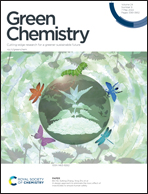Chitin nanowhiskers with improved properties obtained using natural deep eutectic solvent and mild mechanical processing†
Abstract
Traditionally, chitin nanowhiskers (ChNW) have been synthesized using acid or alkali hydrolysis, which is not a fully green and sustainable process. Here, we demonstrate a novel, two-step, environmentally friendly process for producing chitin nanowhiskers with improved yield and colloidal stability. The process begins by swelling the amorphous regions of native chitin in a Natural Deep Eutectics Solvent (NADES). It is followed by a mild mechanical treatment (defibrillation) by injecting chitin-NADES suspension into rotor-stator colloidal mill filled with water, which is aimed to separate crystalline domains of the native chitin into individual nanowhiskers. This approach produces ChNW suspensions with higher yield and improved colloidal stability when compared to the conventional method of producing ChNW using acid hydrolysis. We hypothesized that this is due to the residual amorphous chitin that remains attached to the surface of the nanocrystalline whiskers, which provides additional steric stability to the ChNW suspensions. Furthermore, we find that ChNW produced by our method has better compatibility with secondary polymer matrices such as polyvinyl alcohol (PVOH), resulting in nanocomposite polymer films with better mechanical performance.



 Please wait while we load your content...
Please wait while we load your content...